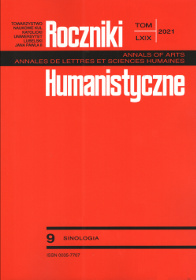A Different Kind of Literacy: On the Non-Binary Aspects of Orality and Literacy in Chinese Literature Illustrated by Selected Examples
Abstract
The main aim of this article is to demonstrate that the dichotomous model of orality and literacy, as proposed, for example, by Walter Ong, as well as other, more culturally “flexible”, tools, such as Ruth Finnegan’s definitions of these terms, are not applicable or else applicable only partially. Due to the growing doubts as to the methodological correctness of the application of these tools as adopted in the West, an attempt was made to present the essence of Chinese literacy and its very complicated relationship with orality. Research areas for further consideration of these issues are also indicated, and exemplification for these reflections has been provided by selected works, which have not been sufficiently discussed in this context despite quite an extensive bibliography on orality and literacy in China.
References
Analekta. Tłum. i oprac. Katarzyna Pejda. Wydawnictwa Uniwersytetu Warszawskiego, 2018.
Baidu. baike.baidu.com/pic/%E6%9B%B0/9421784/0/78310a55b319ebc4b74584119e6fd8fc1e178 b82b8a8?fr=lemma&ct=single#aid=0&pic=78310a55b319ebc4b74584119e6fd8fc1e178b82b8a8. Dostęp 23.03.2021.
Baidu. baike.baidu.com/pic/%E7%A5%9D/54167/0/9a504fc2d56285355d3f24ea9cef76c6a6ef6 31a?fr=lemma&ct=single#aid=0&pic=9a504fc2d56285355d3f24ea9cef76c6a6ef631a. Dostęp 23.03.2021.
Beecroft, Alexander. “Oral Formula and Intertextuality in the Chinese ‘Folk’ Tradition(Yuefu)”. Early Medieval China, no. 15, 2009.
Birrell, Anne. The Classic of Mountains and Seas. London: Penguin Books, 1999.
Brokaw, Galen. “An Integrational Approach to Colonial Semiosis”. The Routledge Hispanic Studies Companion to Colonial Latin America and Carribean (1492-1898), red. San-Miguel Martinez. Routledge, 2021.
Chang, K.C. Art, Myth and Ritual. The Path to Political Authority in Ancient China. Harvard University Press, 1983.
Chinesenotes. chinesenotes.com/wenxin/wenxin001.html. Dostęp 20.03.2021.
Chinese Text Project. ctext.org/guanzi/nei-ye. Dostęp: 25.03.2021.
Chinese Text Project. ctext.org/shan-hai-jing/nan-shan-jing. Dostęp 25.03.2021.
Chinese Text Project. ctext.org/wiki.pl?if=gb&chapter=29&remap=gb#%E4%BD%93% E9% 81%93%E7%AC%AC%E4%B8%80. Dostęp 27.03.2021.
Chinese Text Project. ctext.org/wiki.pl?if=gb&chapter=903927. Dostęp 25.03.2021.
Copp, Paul. “Anointing Phrases and Narrative Power: A Tang Buddhist Poetics of Incantation”. History of Religions, vol. 52, no. 2, 2012.
Encyclopedia of Taoism, red. Fabrizio Pregadio, Routledge, 2008.
Estetyka chińska. Antologia, red. Adina Zemanek, Universitas, 2007.
Finnegan, Ruth. “How Oral Is Oral Literature”. Bulletin of the School of Oriental and African Studies, vol. 37, no, 1, 1974.
Finnegan, Ruth, Oral Traditions and the Verbal arts. A Guide to research Practices. Routledge, 1992.
Finnegan, Ruth. Oral Literature in Africa. Open Book Publishers, 2012.
Gang Yue. Then Mouth that begs. Hunger, Cannibalism and the Politics of Eating in Modern China. Duke University Press, 1999.
Ge, Liangyan. Out of the Margins. The Rise of Chinese Vernacular Fiction. University of Hawai‘i Press, 2001).
Goody, Jack. Literacy in Traditional Societies. Cambridge University Press, 1968.
Hansen, Chad. “Ideographs and Western Ideas”. The Journal of Asian Studies, vol. 52, no, 2, 1993.
Idema, Wilt, i Lloyd Haft. A Guide to Chinese Literature. The University of Michigan, Center for Chinese Studies, 1996).
The Interplay of the Oral and the Written in Chinese Popular Literature, red. Vibeke Børdahl i Margaret B. Wan, Niass Press, 2010.
Kasarełło, Lidia. Totemy życia… Chińska literatura poszukiwania korzeni. Wydawnictwo Dialog, 2000.
Keightley, David M. Sources of Shang History. The Oracle-Bone Inscriptions of Brozne Age China. Universty of California Press, 1985.
LaFargue, Michael. The Tao of the Tao Te Ching. State University of New York Press, 1992.
Hsieh, Liu. The Literary Mind and the Carving of Dragons. Tłum. Vicent Yu-chung Shih. The Chinese Univeristy of Hong Kong Press, 2015, epub.
Liu, J.Y. James, Chinese Theories of Literature. The University of Chicago Press, 1975.
Lord, Albert B. The Singer of Tales. New York, Atheneum, 1971.
Luxun. 魯迅. 中國小說史略 [Zhongguo xiaoshuo shi lue]. 上海古籍出版社 [Shanghai guji chuban she], 2006.
Mair, Victor. T’ang Transformation Texts. A Study of the Buddhist Contribution to the Rise of Vernacular Fiction and Drama in China. Harvard University Press, 1989.
Mair, Victor, and Mark Bender. The Columbia Anthology of Chinese Folk and Popular Literature. Columbia University Press, 2011.
McLaren, Anne. Perfroming Grief. Bridal Laments in Rural China. University of Hawai‘i Press, 2008.
NTI Reader. ntireader.org/taisho/t2003_06.html. Dostęp: 25.03.2021.
Ong, Walter J. Oralność i piśmienność. Słowo poddane technologii. Tłum. i red. naukowa Józef Japola. Wydawnictwa Uniwersytetu Warszawskiego, 2011.
Paśnik, Ewa, Duchy i czary chińskie czyli palimpsestowy charakter zebranych zapisków o zjawiskach nadprzyrodzonych. Wydawnictwa Uniwersytetu Warszawskiego, 2013.
The Platform Sutra of the Sixth Partiarch. Tłum. John Mc Rae. Numata Center for Buddhist Translation and Research, 2000.
Podręczny słownik terminów literackich, red. Janusz Sławiński, Wydawnictwo Open, 1994.
Qiu, Xigui. “The Early China Forum An Examination of Whether the Charges in Shang Oracle-Bone Inscriptions are Questions.” Early China, vol. 14, 1989.
Religa, Małgorzata. “Kanoniczne księgi Chin”. Wielkie księgi ludzkości, red. Anna Czajka, Wydawnictwo Uniwersytatu Kardynała Wyszyńskiego, 2013.
Roth, Harold. Inward Training (Nei-yeh) and the Foundations of Taoist Mysticism. Columbia University Press, 1999.
Shen, Pei. 沈培. 說古文字裏的“祝”及相關之字.《簡帛》[Shuo guwenzi li de “zhu” jí xiāngguān zhī zì,“jiǎn bó”], t. 2, 上海古籍出版社,[Shanghai gují chuban she], 2007.
Słupski, Zbigniew. Wczesne piśmiennictwo chińskie. Wydawnictwo Agade, 2001.
Sørensen, Henrik H., “Spells and Magical Practices as Reflected in Early Chinese Buddhist Sources (c. 300-600 CE) and Their Implication for the Rise and Development of Esoteric Buddhism.” Chinese and Tibetan Esoteric Buddhism, red. Yael Bentor i Meir Shahar, Brill, 2017.
Strickmann, Michel. Chinese Magical Medicine. Stanford University Press, 2002.
Takács, Dániel V. “Performing Eternally: Visible Signs of Oral Tradition in Ancient Egypt”. The Art, the Oral and the Written Intertwined in African Cultures, red. Zuzanna Augustyniak i Hanna Rubinkowska-Anioł. Seria: The Artistic Traditions of Non-European Cultures, t. 6. Polish Institute of World Art & Tako Publishing House, 2018.
Wang, Youru. Historical Dictionary of Chan Buddhism. Rowman & Littlefield, 2017.
Wéijī baike. 维基百科. zh.wikipedia.org/wiki/%E7%AC%A6%E7%B1%99#/media/File: Taoist Charm.JPG. Dostęp 26.03.2021.
Ze, David. “Walter Ong’s Paradigm and Chinese Literacy.” Canadian Journal of Comunication, www.holst.no/Ingar.Holst.Publishing.Co/docs/WalterOngsParadigmandChineseLiteracy.pdf. Dostęp 24.03.2021.
Copyright (c) 2021 Roczniki Humanistyczne

This work is licensed under a Creative Commons Attribution-NonCommercial-NoDerivatives 4.0 International License.





